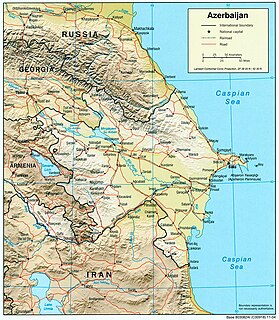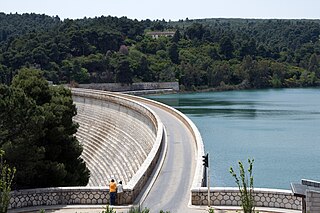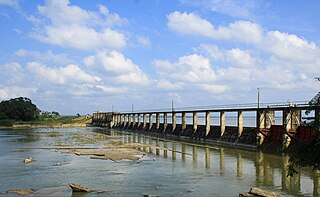
The transport in Azerbaijan involves air traffic, waterways and railroads. All transportation services in Azerbaijan except for oil and gas pipelines are regulated by the Ministry of Transportation of Azerbaijan Republic.

The National Water Carrier of Israel is the largest water project in Israel, completed in 1964. Its main purpose is to transfer water from the Sea of Galilee in the north of the country to the highly populated center and arid south and to enable efficient use of water and regulation of the water supply in the country. Up to 72,000 cubic meters of water can flow through the carrier each hour, totalling 1.7 million cubic meters in a day.

The Governor Edmund G. Brown California Aqueduct is a system of canals, tunnels, and pipelines that conveys water collected from the Sierra Nevada Mountains and valleys of Northern and Central California to Southern California. Named after California Governor Edmund Gerald "Pat" Brown Sr., the over 400-mile (640 km) aqueduct is the principal feature of the California State Water Project.

Anamur is Anatolia's southernmost point, a coastal resort famous for its bananas and peanuts.

The Tehri Dam is the tallest dam in India. It is a multi-purpose rock and earth-fill embankment dam on the Bhagirathi River near Tehri in Uttarakhand, India. It is the primary dam of the THDC India Ltd. and the Tehri hydroelectric complex. Phase 1 was completed in 2006. The Tehri Dam withholds a reservoir for irrigation, municipal water supply and the generation of 1,000 megawatts (1,300,000 hp) of hydroelectricity. The dam's 1,000 MW variable-speed pumped-storage scheme is currently under construction with expected commissioning in 2022.

The Atatürk Dam, originally the Karababa Dam, is a zoned rock-fill dam with a central core on the Euphrates River on the border of Adıyaman Province and Şanlıurfa Province in the Southeastern Anatolia Region of Turkey. Built both to generate electricity and to irrigate the plains in the region, it was renamed in honour of Mustafa Kemal Atatürk (1881–1938), the founder of the Turkish Republic. The construction began in 1983 and was completed in 1990. The dam and the hydroelectric power plant, which went into service after the upfilling of the reservoir was completed in 1992, are operated by the State Hydraulic Works (DSİ). The reservoir created behind the dam, called Lake Atatürk Dam, is the third largest in Turkey.

Nagarjuna Sagar Dam is a masonry dam across the Krishna River at Nagarjuna Sagar which straddles the border between Nalgonda district in Telangana and Guntur district in Andhra Pradesh. The dam provides irrigation water to the Nalgonda, Suryapet, Krishna, Khammam, West Godavari, Guntur, and Prakasam districts along with electricity generation.

The Ross River Dam is a rock and earthfill-filled embankment dam across the Ross River, located between Kelso and Mount Stuart in the City of Townsville in northern Queensland, Australia. Built initially for flood control, Lake Ross, the impoundment created by the dam, serves as one of the major potable water supplies for the region.

Lago Bianco is a reservoir at the Bernina pass in the Swiss canton of Graubünden. It has an elevation of 2,234 m (7,329 ft), a length of 2.85 km (1.77 mi), a surface area of 1.50 km2 (0.58 sq mi) and a maximum depth of 53 m (174 ft). Once the site of two smaller lakes, the current reservoir was formed by the constructions of two dams at its southern and northern ends. The current lake drains to the south, as did both its precursor lakes, with its water eventually reaching the Mediterranean via the rivers Poschiavino, Adda and Po. By contrast, Lej Nair, just below the northern dam. drains north into the Black Sea via the rivers Inn and Danube.

Split Rock Dam is a minor ungated concrete faced rock fill embankment dam with concrete chute spillway across the Manilla River upstream of Manilla in the north-western slopes region of New South Wales, Australia. The dam's purpose includes flood mitigation, irrigation, water supply and conservation. The impounded reservoir is called Split Rock Reservoir.
Şanlıurfa Irrigation tunnels is the name of a major irrigation tunnel constructed in connection with the Southeastern Anatolia Project, a multi-sector integrated regional development project of Turkey. The tunnels were commissioned by the State Hydraulic Works authority (DSİ). The constructor was Eren İnşaat. The construction ended by 19 December 2005 and the tunnels were put into service.

The Marathon Dam is a gravity dam on the Charadros River, near its junction with the Varnavas Stream, 8 km (5 mi) west of Marathon and 45 km (28 mi) northeast of Athens in Greece. The dam created Lake Marathon for the primary purpose of municipal water supply. Constructed between 1926 and 1929, it was the sole supplier of water to Athens until 1959. The dam is often cited for its role in the modernization of Greece and the first recorded case of seismic activity associated with reservoir inundation. It was also designed to be symbolic of Ancient Greece, particularly Athenians and the Battle of Marathon.
Kosasthalaiyar River, also known as Kortalaiyar, is one of the three rivers that flow in the Chennai metropolitan area.
Water supply and sanitation in Iraq is characterized by poor water and service quality. Three decades of war, combined with limited environmental awareness, have destroyed Iraq's water resources management system. Thus, Iraq faces difficulties to realize the target of 91% of households using safe drinking water supply by 2015. Currently, 16% of households report daily problems with supply and 20% use an unsafe drinking water source. Furthermore, animal waste and septic tanks pollute the drinking water network.(11)

Alaköprü Dam is a concrete-face rock-fill dam on the Anamur (Dragon) Creek in Anamur district of Mersin Province, southern Turkey. The development is backed by the Turkish State Hydraulic Works (DSİ). The dam was primarily built as part of the Northern Cyprus Water Supply Project, to supply water for drinking and irrigation to Northern Cyprus.

Yellow Pinch Dam is a major off-stream ungated rockfill embankment dam across the Yellow Pinch Creek upstream of Merimbula in the South Coast region of New South Wales, Australia. The dam's main purpose is water supply. The impounded reservoir is also called Yellow Pinch Dam.

The Geçitköy Dam is a rock-fill dam on the Mandara River about 8 km (5.0 mi) west of the town of Lapithos in Cyprus. The dam is located in the de facto territory of Northern Cyprus. It was originally completed as the Dağdere Dam in 1989 but between 2012 and 2014 it was raised and expanded into its current form. The dam is part of the Northern Cyprus Water Supply Project and receives water not only from the river but via an undersea pipeline connected to the Alaköprü Dam, located near the southern shores of Mersin Province, Turkey. Construction on main works for the dam began on 30 March 2012 and it was completed on 7 March 2014. The new dam increased the reservoir capacity from 1,800,000 m3 (1,500 acre⋅ft) to 35,000,000 m3 (28,000 acre⋅ft). Water from Turkey first entered the reservoir on 17 October 2015. From there it is transferred via pumps to Girne which lies to the east.

Iranamadu Tank is an irrigation tank in northern Sri Lanka, approximately 3 mi (5 km) south east of Kilinochchi.

Dragon Creek, also called Kocaçay or Anamur Creek, is a creek in Anamur district of Mersin Province, southern Turkey.
Lake Tuz Natural Gas Storage is an underground natural gas storage facility under construction in Aksaray Province, central Turkey. It was developed artificially in a salt formation.

















